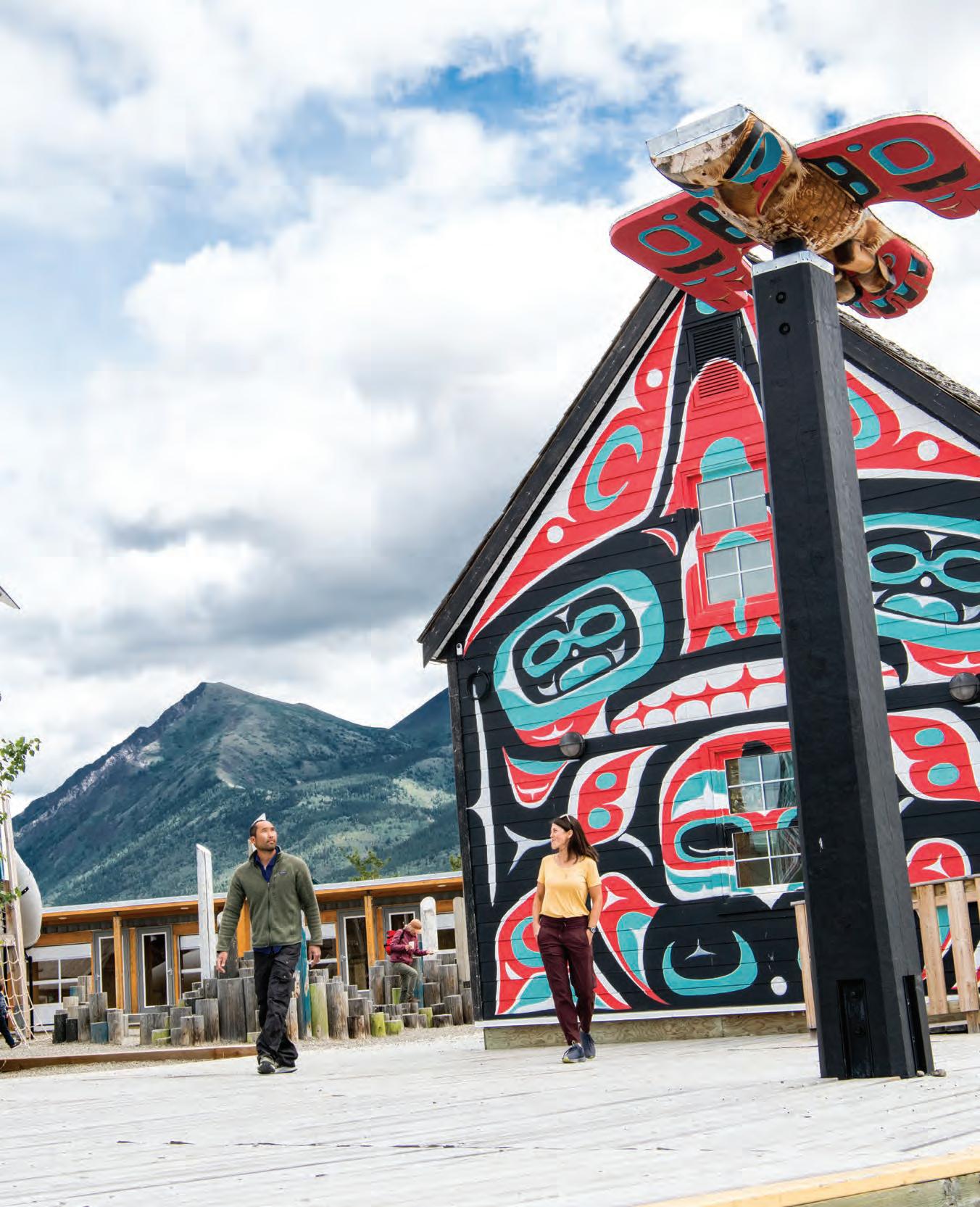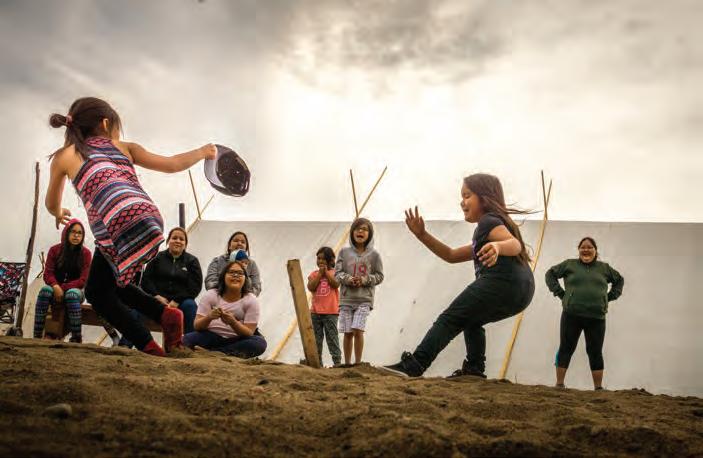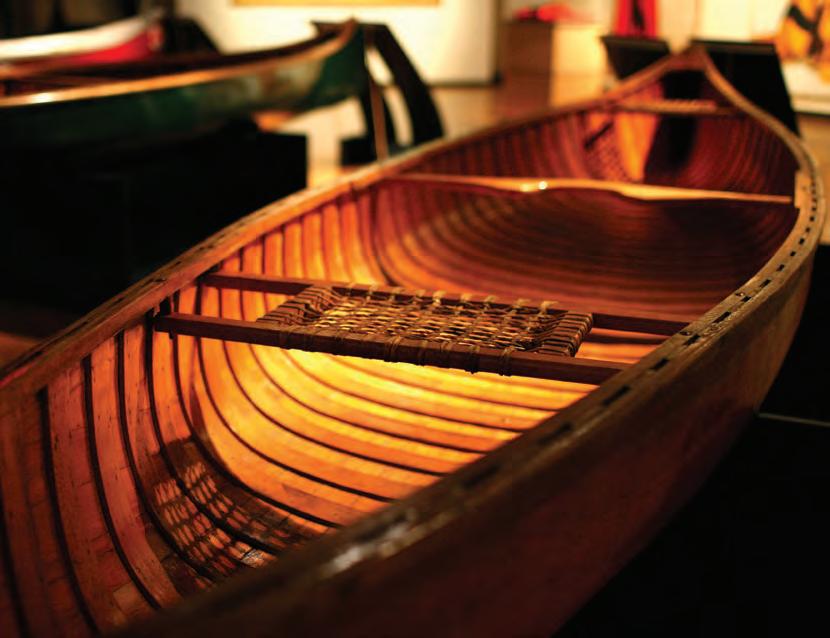
8 minute read
Shared Traditions and Storied History
For many Indigenous communities across Canada, Traditional Knowledge and storytelling are vital for preserving culture, language, ways of being, and educating future generations while providing necessary connections to their ancestors. Whether they are creation stories, medicine teachings, or historical accounts of lived experiences, they have been shared for thousands of years, many without ever being transcribed.
BY TRAVIS KLEMP
+EXPLORE FURTHER ONLINE
Carcross/ Tagish Management Corporation

Across the country, these traditions and stories are shared within communities by Elders. However, there are also many cultural centers throughout the country that are innovatively ensuring Traditional Knowledge is accessible to everyone.
Whether it be multi-sensory, full immersion cultural centers or archival museums you can experience the history of living, breathing cultures and gain a deeper understanding of the lands you inhabit.
Onhoüa Chetek8e Huron Traditional Site
offers an immersive view into the HuronWendat Peoples and their traditional ways of life through guided tours on foot and in canoes, medicine creation from deer leather and learn about the unique social organization of the Huron-Wendat People before colonization. End your visit with the outstanding closing Friendship Dance. [huron-wendat.qc.ca]
A similarly innovative experience lies at the Maison de la Culture Innue, also in the province of Quebec. As a place to learn about the Innu People of Ekuanitshit on traditional territory while gazing across the Mingan Archipelago. Explore the Innu-aimun language and culture of the Innu People at the site where they would come for the summers. Knowledge keepers graciously share artisanal and medicine teachings. [maisoncultureinnue.com]
Maison amérindienne at Mont-Saint-Hilaire focuses not only on the environment and museum but also on visitors’ taste buds. Several traditional dishes and maple products help you learn about First Nations in this territory including the famous cassoulet, a slow-cooked stew made with beans simmered in earthenware containers with duck and fat. Temporary exhibits arrive each year to accompany the multiple permanent ones such as Water… To the Mouth, a look at the Indigenous usage of sap and origin of maple syrup long before the arrival of Europeans. [maisonamerindienne.com]
Maison de la Culture Innue
The traditions, language, art, and spirituality of the Anishinaabe People of the Mnidoo Mnising are celebrated at The Ojibwe Cultural Foundation on M’Chigeeng First Nation. While the 11,000 square feet of space may seem vast, it is overflowing with opportunities to learn about the Anishinaabe ways of knowing and being. From the museum, art gallery and healing lodge to the full immersion Ojibwe early learning program and first all Anishinaabe radio station, Gimaa Radio, there is something for every guest who visits. [ojibwe-cultural-foundation. myshopify.com]
Heading north to the Yukon, the Kwanlin Dun Cultural Centre in Whitehorse was built in 2012 to honour and remember the foot trails of the Chu Níikwän (now Yukon River) that were drastically changed by the Klondike Gold Rush in the late 1800s. Now serving as one of the foremost convention centers in the Yukon, it also houses a public library and many cultural artifacts. Plan ahead for the Indigenous artists-in-residence who make the center their home for the summer months and take part in the Moosehide to Moccasins workshops. [kdcc.ca]
Storyteller Profiles
Rita Mestokosho, General Manager Maison de la Culture Innue
Rita Mestokosho is a poet and writer from Ekuanitshit, an Innu community on Quebec’s North Shore. A passionate activist, her work exposes her struggle for the preservation of her homeland, her first language and her Innu Culture. Rita has also published two books, contributes to several publications, anthologies and collective works.
La Maison amérindienne

The Ojibwe Cultural Foundation
Storyteller Profiles

Candace Campo, Owner / Operator Talaysay Tours
We get to introduce guests throughout the world and even our local community members to the rich history and culture of our people. We get to share our experiences on the land with our guests and those are special moments. It doesn’t matter how many times you’ve done that tour, it’s a unique experience that’s shared together between host and guest.”

Whitehorse is also home to the Carcross/Tagish Management Corporation where you can visit the Haa Shagóon Hídi Learning Centre (the house of our ancestors). Visitors will be struck by the outstanding art and eight towering totem poles that greet you at the entrance. Be ready to head back outside after grabbing a cup of coffee because the interpretive walk along Nares Lake is essential. For those feeling even more adventurous, mountain biking and hiking trails take you onto the land and give you the opportunity to immerse yourself in your unbelievable, glacier populated surroundings. [destinationcarcross.ca]
Back in Quebec in Mi’Kmaq territory, an environmental immersion experience is also offered at the Gespeg Mi’Kmaq Interpretation Site. The North shore of the Gaspé Bay is absorbed by the forest and picturesque mountains and is where the interpretation site lives. Guided tours will take visitors on a journey from past to present and help illuminate the storied and beautiful history of the People of the sea, the Mi’Kmaq. Permanent exhibitions share writings from the first missionaries and explorers as well as traditional clothing as hunting and fishing tools. [micmacgespeg.ca]
Gespeg Mi’kmaq Interpretation Site
Storyteller Profiles
David Daley, Owner Wapusk Adventures
Dave Daley says his favourite part about working in tourism is sharing his Indigenous culture, something he wasn’t always able to do. “It wasn’t fashionable to be Indigenous in the 60s and 70s. We always did things in secret or kept it within the family. Now we’re free to share our culture. It’s fun to be open!”
The archive at the Native
Museum of Mashteuiatsh
is equally as expansive. As one of the most comprehensive repositories for the preservation of Pekuakamiulnuatsh culture, the Native Museum of Mashteuiatsh provides visitors with a journey into the past lives of the Innu/ Ilnu People as they nomadically navigated the land and waters of the region. Take in the temporary exhibits and permanent installation called The Spirit of Pekiakamiulnu or travel the interpretation trail and learn about food and medicine gathering deep in the boreal forest. [museeilnu.ca]



Abénaki Museum
Lennox Island Mi’kmaq Culture Centre Further east in Prince Edward Island, the Lennox Island Mi’kmaq Culture Centre on the land and water that the Mi’kmaq People have treasured and cared for spanning 10,000 years, offers a natural beauty and environmental immersion. The Path of our Forefathers allows you to walk with those both past and present that have cherished the land and stop on the beach for the extremely unique experience of making Bannock and Clams in the sand along the shores of Lennox Island. From traditional storytelling, to rattle and drum making, to beach bark and porcupine quill work, there is a wide range of ways to learn about the culture on the island. [lennoxisland.com]
The Abénaki Museum in Odanak, Quebec houses an astonishing 26,000 Indigenous artifacts and art celebrating and preserving the culture of the people – one of the eleven Algonquin speaking Peoples in Quebec. The collection includes everything from baskets weaved with the traditional K8wis, or “thorn” patterns, to beautifully sculpted items and traditional utensils used in the past. The uniquely stunning Wôbanaki: people of the rising sun permanent exhibit shares a journey explaining the Abenaki People’s way of life and spirituality following the rhythm of the seasons and lunations. [museeabenakis.ca]
Allow the 40-foot statue of Glooscap to welcome you at the Millbrook
Cultural & Heritage
Centre in Nova Scotia. Engage all of your senses while learning about the Mi’kmaw connection to the Bay of Fundy through the handling of furs, porcupine quills, sweetgrass, and traditional instruments. The tremendously knowledgeable interpreters guide you through the culture’s beautiful ways of life and changing relationship with European settlers. [millbrookheritagecentre.ca]
Abénaki Museum


Out west at Blackfoot Crossing in Southern Alberta, you can experience the place where Treaty 7 was signed and walk the sacred ground just as 10,000 Blackfoot warriors did in the past. The fully interactive historical park is a home for in-depth history and traditional practices of the Blackfoot People and Siksika Nation. Honoured Elders share traditional stories—an extremely moving experience— and Chief Crowfoot’s Tipi Village offers a glimpse at traditional practices such as tanning and smoking, dances, and tipi teachings. [blackfootcrossing.ca]
The Huron-Wendat Museum in Quebec is truly a conservatory for the preservation and enhancement of the Huron-Wendat culture. Although the museum opened in 2008, Wendat cultural agents have worked to preserve the continuity of the spirit of conservation and bring together artifacts that make up the museum’s collection today. A fully immersive experience is offered alongside the museum’s archives including a restaurant with culturally inspired dishes, a 4-star hotel, an art and craft boutique and the Nation Health-Spa overlooking the Akiawenrahk’ river. [hotelpremieresnations.ca]
See and feel the history and living Culture of the Huron-Wendat Nation through powerful performances [at Huron-Wendat Museum.]
Blackfoot Crossing
Storyteller Profiles
Marilyn Jensen, Leader / Dancer Dakhká Khwaán Dancers
“There are so many moments when we’re dancing, singing and drumming and as a group, we’re really interconnected and we sometimes go into another realm. And I’ll catch a glimpse of someone in the audience witnessing this and I can see that they are bawling. That their spirit has been touched as well as their heart.”
Huron‑Wendat Museum










